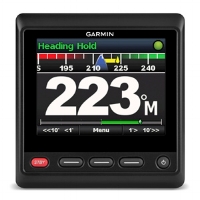AutoPilot
Fir was never fitted with an autopilot. Helmsmen worked in four hour shifts, and manually steered every turn. This was routinely boring and, in heavy weather, an exhausting job. An autopilot system will reduce our crew requirement as a person can more easily monitor the wheel than steer.. Further, an autopilot is a precise instrument, designed to save time and fuel
Head
Head for the Simrad AP-70
A control head is the user interface for an autopilot system. Heads from the major manufacturers are very similar, generally displaying current course, and rudder angle. The presence of buttons or a knob allow for temporary manual steering. More sophisticated systems have multiple modes with steering patterns to suit a variety of situations.
Many control heads provide a remote steering mechanism. This is an important feature for Fir because it will allow us to steer the boat from multiple positions. Our plan is to use the autopilot to support a rudder jog switch at several locations.
Computer
The computer is the device that "decides" how to set the rudder angle to maintain the desired course. The better systems include adaptive "fuzzy" logic allowing the system to consider sea conditions. The computer calculates the boats response to rudder commands in existing sea conditions (e.g. following seas), and decides the best way to maintain course. Within seconds the autopilot adapts to current conditions.
Head for the Garmin GHC-20
In choosing an autopilot system we need to consider vessel size that the autopilot is designed to control. Fir is just under 1,000 tons. She does not turn on a dime. While any adaptive system ought to learn this characteristic, companies that cater to smaller craft may not be as adept with the steering characteristics for much larger vessels. It makes more sense for our autopilot to be designed for the workboat market.
Interestingly, autopilot computers do not typically store multiple waypoints. This is typically done by the chartplotter or navigational computer. A navigation system will build a route that may include several waypoints. The navigational computer will send the course and current waypoint to the autopilot computer. When the waypoint is reached, the navigation system supplies the autopilot computer with a course to the next waypoint. The autopilot computer's purpose is not to store vast amounts of waypoints, but to decide what rudder, and possibly thrusters, will be necessary to maintain a given course.
Actuator
Head for the Furuno 700 Series
The actuator is part of a system that changes rudder position. Autopilots can be configured to connect to the rudder in a number of ways. Connecting an autopilot to a modern steering system should be very simple. The problem with Fir is that her steering system is unique and unconventional.
The wheel of the Fir is connected to the hydraulic pump for the steering rams through a succession of worm gears and propeller shafts. The wheel connects to a shaft via a worm gear. The rudder signal traverses the boat through a series of shafts and worm gears. Eventually, this leads to a small open gear box mounted on the steering pump. This gear box converts the rotational energy to a left-right motion engaging a small tiller. The tiller then connects to a large hydraulic pump and powers the massive rams that control the rudders.
Instead of trying to rework the existing hydraulic system, we are opting for a simpler approach by mimicking the operation of the wheel. We will cut the propeller shaft below the Wheelhouse, and install an electric clutch. With the autopilot off the clutch is disengaged, and the wheel can turn the propeller shaft. This allows steering to work as it was designed. With the autopilot on the clutch is engaged, and the mechanical connection between the wheel and propeller shaft is broken. The movements of the shaft are then controlled by a sprocket, chain, and electric motor.
Head for the Raymarine 500
Sensors
Most GNSS devices typically supply location, heading, and rate of turn data. Better sensors provide additional roll and pitch information. Rudder angle information is delivered by a separate device attached to the rudders. Fir once had a sensor that ran an analogue gauge in the Wheelhouse. The new sensor will be connected to our network so that this information will be available on all devices.
choices
We are considering the following systems: Furuno FAP3000, Simrad AP-70 and Garmin GHC20. Check back to see our evaluation and final choice.




